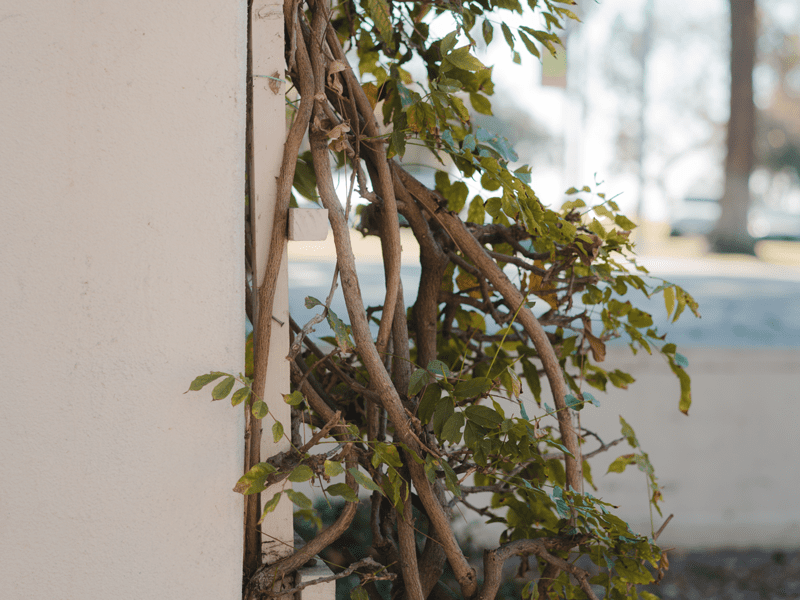In St. Louis, a missional community builds young leaders.
They gathered around 6 p.m. on a balmy Sunday evening, in a large backyard rimmed by rustling trees, the shaggy carpet of grass underfoot growing slightly dewy with Midwestern humidity. Altogether, about 15 neighbors came together—Gigi brought homemade spaghetti, Hannah her chocolate chip cookies. They grilled hot dogs and poured soft drinks, put out a plate of deviled eggs, and offered up brownies and potato chips. And then, for the next few hours, they simply made time to hang out.
Nights like these they call the weekly “check in,” and it’s just one of the low-fi rituals practiced at The Salvation Army’s Urban Mission Center (UMC), a burgeoning community of young Christians in the Benton Park West neighborhood of St. Louis.
Over the past 10 years, as the three-decades old missional community movement has gone mainstream, The Salvation Army is just one of a number of the largely evangelical denominations, from Baptist to Nazarenes, to have created such groups of their own. Whether formally affiliated with an established church or grassroots assemblies of like-minded Christians looking to weave their faith into the fabric of their neighborhoods, hundreds of missional communities—or MCs—have sprung up across the U.S.
For the Army, UMC operates with the stated mission to form leaders, equipping them with the skills and experience to navigate the country’s increasingly complex and urbanized landscape, from a community-based perspective. As such, past residents have included several cadets-in-training, and a collaboration with Olivet Nazarene University began last fall.
But to do that, they first work to instill an ethos of community-building among their residents, otherwise known as “dwellers,” an overtly missional, or community-oriented, philosophy. As to what that means in practice, however, that’s an evolving concept, in keeping with the fluid nature of MCs themselves. “‘Experiment” is a word we use a lot,” said UMC Director Sara Johnson.

Open-mindedness is built into the organization’s DNA. The center isn’t really a center at all, but a cluster of five houses, each with two or three bedrooms, capable of accommodating up to 15 people in total. The project is overseen by Midland’s Urban Ministries Secretary Major Gail Aho, who along with her husband Phil, occupies one of the residences. Johnson lives in another, and the remainder are operating at about half capacity at the moment, a snapshot of the revolving door that is life in one’s 20s. Current tenants include Stephen and Hannah, both students at nearby Covenant Seminary; eleven months in, they’ve already signed up for a second year. Then there’s Jessica and Kamaria and also April, who on the evening of the BBQ had until midnight to decide whether to head out west for grad school or to accept a Christian writers’ residency. Darren and Charlene just purchased a home in the neighborhood, around the time Lexi moved in. Andrew arrived in August.
Each came to the center through different paths. Sara met Lexi at Greenville College, a small Christian school about an hour away on the Illinois side of the Mississippi River. Hannah learned about the program from a friend. Kamaria is currently the only resident to be raised in the Army. They attend Temple Corps on Sunday.
Dwellers, accepted after a multi-part application process, pay a $100/month programming fee, which covers guest lectures and other events. Housing itself is free. In addition to the Sunday evenings catch up and check in, center members meet up every Tuesday for dinner. On Wednesday evenings, they individually take an hour to pray for the neighborhood, with a lit a candle placed in each window—an idea Aho borrowed from some Episcopalian friends in Nashville. Beyond that, roughly 10 hours a week of volunteer work on behalf of the center are required.
In return, dwellers receive experience working with the Army in a number of facets, including with the area youth, helping out seniors in the community garden and slots preaching at the local corps.
“We give them opportunities for ministry in all kinds of ways,” Aho said. “We just give them a feel for all the stuff that we do here in St. Louis.”
But just as important is giving them a feel for St. Louis. Often dwellers, including those aforementioned cadets, have hailed from small towns or rural areas. For them, the center serves as a good introduction to ministry in an urban context, Aho said.
“It’s amazing to me how green a lot of people are,” she said. “They don’t really understand city dynamics. They think they do until they get here and then they’re like ‘whoa, I guess I didn’t realize how noisy it was or how diverse or’—I’m using my three words we talk about all the time: the disparity, the diversity and the density. Those are all things that people do not realize.”
The center is a relatively new initiative for the Midland Division, emerging in late 2014. Prior to its formation, the dwellings served as transitional housing, until that program proved economically unviable. For a brief span then, they sat empty—“that was bad, bad, bad,” Aho said—until the center began to coalesce informally, with a late corps officer bringing in a few young occupants who earned their keep through light renovations. Around 50 dwellers have gone through the program in total.

The neighborhood in which it is located—Benton Park West—is itself in transition, known for both trendy restaurants and gun violence. Ethnically diverse, it’s also home to a mix of older residents alongside newly arrived young urbanites, part of the wave of millennials nationally flocking back to city centers. Named for the state’s first senator—Thomas Hart Benton—early on, Benton Park attracted German immigrants who opened breweries that made use of the numerous limestone caves running underground. Prohibition marked the moment the area first hit the skids. Between the corps, the center and a large complex for senior housing, the Army has had a strong presence here for decades.
Gravitating to underprivileged neighborhoods is a common theme among missional communities, said Jon Huckins, co-author of “Thin Places: Six Postures for Creating and Practicing Missional Community” and a coach at the nonprofit Thresholds, which nurtures MCs around the country. “I have seen lots of communities move to that place that’s kind of an intersection of culture and race and socio-eco standing, because it’s that diversity, obviously, that creates this fertile soil to seed,” he said.
Regardless of where they go, they bring the same command, to not simply love one’s neighbor, but to actually take the time to get to know them. For Huckins, this deep rooting in place isn’t simply meant as an antidote to life in a fragmented world. “It’s a trace back to our roots of the early church, pre-Constantine, in the 4th century,” he said. “And saying, how does the church organize itself on a local level, in a way that was true to the context and took seriously our call to follow Jesus in a place?”
Some missional groups, however, will prioritize affinity, such as age or interests, over proximity. UMC does a bit of both—fully committed to its Benton Park West home and targeted to young adults, the Ahos’ oversight combined with the occasional acceptance of a more mature dweller ensures an intergenerational component. In Huckin’s observation the healthiest missional communities are multi-generational—plenty of young idealists racing forward alone without any seasoned wisdom and council are “just crashing and burning,” he said—but interestingly, this diversity dovetails with larger research that speaks to a concern that many churches are attempting to address by establishing MCs. Namely, studies show that religious communities of all types are more likely to retain their young adult members if they emphasize intergenerational ministry.
After graduating from the Moody Bible Institute in Chicago, 25-year-old dwellers Stephen and Hannah Manyara first landed in St. Louis neighborhood about 15 minutes north of Benton Park West. There, the couple attended a church that wasn’t focused on community engagement. After a year of working with the center, the couple say they couldn’t imagine living anywhere outside Benton Park West. For Stephen, who is studying to become a youth minister, being able to get involved with programs at the Temple Corps has been a particular benefit—a sentiment reciprocated by young corps members who view UMC as bringing in much needed young adult role models.
“This is the perfect blessing—we’re students we don’t have a lot of money, so you get reduced housing, but then…just to have so many resources of like, what are your giftings? Are you good in this area? We’ve got ways to volunteer,” said Hannah. “They just know so many people to plug you in with. It’s just really cool. I never would have guessed that God would have been able to provide in this really practical way for us.”

In fact, such personal stories are a key metric for measuring UMC’s success. In many ways, the center’s emphasis on keeping its programming low-cost offers young adults not just professional development, but also a solid launching pad into adult life. At the same time, its anti-colonial approach—seeking to add value by supporting neighbors rather than simply contributing its own two cents—has built up a profound trust between the center and the community. That was particularly evident when local residents drafted Johnson into running for a city government position, which, with their backing, she won.
That idea, of connecting with neighbors as potential partners rather than converts, gets at one of the major undercurrents running through missional thinking.
– Find more about Sara Johnson’s neighborhood-based ministry approach at caringmagazine.org – Learn about The Salvation Army’s efforts in your community and give to support the effort at westernusa. – Read “Thin Places: Six Postures for Creating and Practicing Missional Community” (The House Studio, 2012) by Jon Huckins and Rob Yackley.
center.com.
/drafted.
salvationarmy.org.
“Another thing about a missional community, it’s inherently provocative and prophetic in regards to calling the church away from consumption,” Huckins said. “It’s not about acquiring ‘X’ number of congregants to consume a service or a product. It’s about committing to a place in all of life. There’s no glitz and glamour about it, but it’s in the mundane of everyday life that we find our community, that we identify what God is doing and choose to join in.
“There’s no struggle to find people who want to live this way,” he said. “It’s just that many aren’t being offered any example of it or a model of it.”
“The question is why,” Aho began musing as the platter of cookies made its way around the backyard picnic table. “Why has the Army come back to the city? Why now? Why have they handed us money to do this now? Because a lot of people, they’ve seen the video, they’ve kind of heard some of this, but they don’t really get why we’re doing it.”
“I just want to share how for me, personally, this journey has been one of continually being humbled and it’s not my job to save my neighborhood,” said Johnson. “God is here and he’s working—”
“And he was here long before us,” Aho finished her sentence. Without skipping a beat, she then launched into a long story about a Russian piano player, a woman who’d began studying classical music at the age of seven only to arrive at adulthood incapable of making a living at her trade. Suddenly, however, the conversational threads began to coalesce.
“There was this phrase she used that reminded me of kind of what we’re doing,” Aho said. “She called it a catastrophic failure.”
Yet that young woman’s epic disappointment only prompted her to redirect her energies—and become a successful musician in a different genre.
“I feel like the Army—at least in the Central Territory, we might be the only territory that’s dealing with this,” Aho continued with a wry laugh, “but we’re faced with this catastrophic failure as far as our Salvation Army Sunday mornings and traditional programs. People are not coming to them anymore. It’s done, it’s over. We have this feeling that we’re washed up, right?”
But that’s only created an environment in which to experiment with new approaches, she continued—while keeping in mind that a quest for the next thing doesn’t mean sacrificing the traditional grounding that made the Army what it is.
“So you’re not going to lose that at all, but it does allow for some really fun and interesting looks at all of it,” she said. “Which I find really fun to think about. And to try.”












